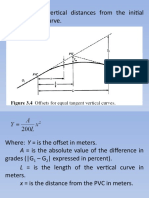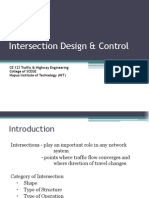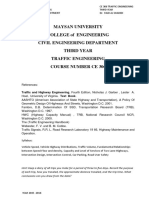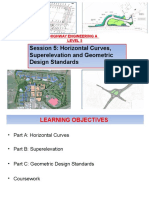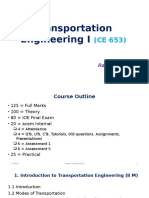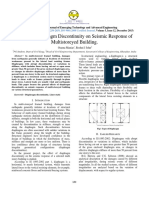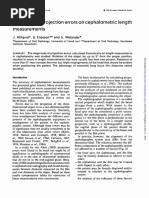Geometric Design of Highways Part 2 PDF
Geometric Design of Highways Part 2 PDF
Uploaded by
jun junCopyright:
Available Formats
Geometric Design of Highways Part 2 PDF
Geometric Design of Highways Part 2 PDF
Uploaded by
jun junOriginal Title
Copyright
Available Formats
Share this document
Did you find this document useful?
Is this content inappropriate?
Copyright:
Available Formats
Geometric Design of Highways Part 2 PDF
Geometric Design of Highways Part 2 PDF
Uploaded by
jun junCopyright:
Available Formats
GEOMETRIC DESIGN OF HIGHWAYS
II. DESIGN OF ALIGNMENTS
The alignment of a highway is composed of vertical and horizontal elements. The vertical alignment includes
straight (tangent) highway grades and the parabolic curves that connect these grades. The horizontal alignment
includes the straight (tangent) sections of the roadway and the circular curves that connect their change in
direction.
The design of the alignment depends primarily on the design speed selected for the highway. The least
costly alignment is one that takes the form of the natural topography. It is not always possible to select the lowest
cost alternative because the designer must adhere to certain standards that may not exist on the natural
topography. It is important that the alignment of a given section has consistent standards to avoid sudden
changes in the vertical and horizontal layout of the highway. It is also important that both horizontal and vertical
alignments be designed to complement each other, since this will result in a safer and more attractive highway.
A. DESIGN OF VERTICAL ALIGNMENTS
The vertical alignment of a highway consists of straight sections known as grades, (or tangents) connected
by vertical curves. The design of the vertical alignment therefore involves the selection of suitable grades for
the tangent sections and the appropriate length of vertical curves. The topography of the area through which
the road traverses has a significant impact on the design of the vertical alignment.
Vertical curves are used to provide a gradual change from one tangent grade to another so that vehicles
may run smoothly as they traverse the highway. These curves are usually parabolic in shape and has two
types.
1. SYMMETRICAL PARABOLIC CURVES
In highway practice, the abrupt change in the vertical direction of moving vehicles should be avoided
thus a parabolic curve is adopted to provide a general change in the vertical direction.
(a) Crest Vertical Curves or Parabolic Summit Curves
(b) Sag Vertical Curves or Parabolic Sag Curves
CE 317: Highway and Railroad Engineering
GEOMETRIC DESIGN OF HIGHWAYS
Where: G1, G2 = g1, g2 = Grades of the Tangents (%)
A = Algebraic Difference of the Grades
L = Length of Vertical Curve
PVC = PC = Point of Vertical Commencement/Curvature/Curve
PVI = PI = V = Point of Intersection of the Tangents = Vertex
PVT = PT = Point of Vertical Tangency/Tangent
SYMMETRICAL PARABOLIC CURVE FORMULA SET
• Equal Middle Ordinate and Exterior Distance (H) NOTE:
𝑳 Include the sign convention of
𝑯 = (𝒈𝟏 − 𝒈𝟐 ) the grades in your calculations.
𝟖
• From the Squared Property of Parabola
𝟐
𝒙𝟐 (𝑳⁄𝟐)
=
𝒚 𝑯
• Location of the highest/lowest point of the curve from P.V.C.
𝒈𝟏 𝑳
𝑺𝟏 =
𝑯
• Length of Curve w/ a given meter station (S)
|𝑨|
𝑳 = 𝑺𝒏 @ 𝒏=
𝑹𝒂𝒕𝒆 𝒐𝒇 𝑪𝒉𝒂𝒏𝒈𝒆
NOTE: Same principles and formula are used when solving Symmetrical Parabolic Sag Curves.
CE 317: Highway and Railroad Engineering
GEOMETRIC DESIGN OF HIGHWAYS
2. UNSYMMETRICAL PARABOLIC CURVES
A curve is said to be unsymmetrical if the length of the curve at each side of the vertex is not equal. In
vertical highway curves, two parabolas are constructed in order to make the entire curve smooth and
continuous.
UNSYMMETRICAL PARABOLIC CURVE FORMULA SET
• Equal Middle Ordinate and Exterior Distance (H) NOTE:
𝑳𝟏 𝑳𝟐 Include the sign convention of
𝑯= (𝒈 − 𝒈𝟐 )
𝟐(𝑳𝟏 + 𝑳𝟐 ) 𝟏 the grades in your calculations.
• Third Grade (g3) Formula
𝒈𝟑 (𝑳𝟏 + 𝑳𝟐 ) = 𝒈𝟏 𝑳𝟏 + 𝒈𝟐 𝑳𝟐
• Location of the highest/lowest point of the curve
𝑳𝟏 𝒈𝟏
• From P.V.C. when <𝑯
𝟐
𝒈𝟏 𝑳𝟏 𝟐
𝑺𝟏 =
𝟐𝑯
𝑳𝟏 𝒈𝟏
• From P.V.T. when >𝑯
𝟐
𝒈𝟐 𝑳𝟐 𝟐
𝑺𝟐 =
𝟐𝑯
B. DESIGN OF HORIZONTAL ALIGNMENTS
The horizontal alignment consists of straight sections of the road (known as tangents) connected by
curves. The curves are usually composed of segments of circles, which have radii that will provide for a smooth
flow of traffic. The design of the horizontal alignment entails the determination of the minimum radius,
determination the length of the curve, and the computation of the horizontal offsets from the tangents to the
curve to facilitate locating the curve in the field. In some cases, to avoid a sudden change from a tangent with
infinite radius to a curve of finite radius, a curve with radii varying from infinite to the radius of the circular curve
is placed between the circular curve and the tangent. Such a curve is known as a spiral or transition curve.
There are four types of horizontal curves: simple, compound, reversed, and spiral.
CE 317: Highway and Railroad Engineering
GEOMETRIC DESIGN OF HIGHWAYS
1. SIMPLE CURVES
Simple circular curves consist of a circular arc of radius (R) connecting two tangent lines (T) at the
tangent point called the Point of Intersection (P.I.) at specific Angle of Intersection (I). The curve starts at
the Point of Commencement (P.C.) and ends at the Point of Tangency (P.T.).
Where:
D = Degree of Curve X = Offset Distance
LC = Length of Curve C = Length of Chord
M = Middle Ordinate ί = θ/2 = Deflection Angle
E = External Distance θ = Central Angle
SIMPLE CURVE FORMULA SET
• Degree of Curve
𝟏𝟏𝟒𝟓.𝟗𝟏𝟔
• Arc Basis 𝑹= NOTE:
𝑫 Arc Basis is commonly used for
𝟏𝟎 the Curve Radius of items of
• Chord Basis 𝑹= unspecified basis method.
𝐬𝐢𝐧(𝑫⁄𝟏𝟎)
𝑰
• Tangent Distance 𝑻 = 𝑹 𝐭𝐚𝐧 ( )
𝟐
𝑰
• Middle Ordinate 𝑴 = 𝑹 (𝟏 − 𝐜𝐨𝐬 ( ))
𝟐
𝑰
• External Distance 𝑬 = 𝑹 (𝐬𝐞𝐜 ( ) − 𝟏)
𝟐
𝑰
• Long Chord 𝑪 = 𝟐𝑹 𝐬𝐢𝐧 ( )
𝟐
𝝅
• Length of Curve 𝑳𝑪 = 𝑹𝑰 𝟏𝟖𝟎
CE 317: Highway and Railroad Engineering
GEOMETRIC DESIGN OF HIGHWAYS
2. COMPOUND CURVES
A compound curve is a combination of two or more circular curves with the center of curvature on the
same side of the curve. The point where the two circular curves meet is called the Point of Compound
Curve (P.C.C.).
Where:
I = I1 + I2 = Angle of Intersection of the
Compound Curve
I1 = Angle of Intersection of the FIRST
Simple Curve
I2 = Angle of Intersection of the SECOND
Simple Curve
R1 = Radius of Curvature of the FIRST
Simple Curve
R2 = Radius of Curvature of the SECOND
Simple Curve
T1 & T2 = Tangent Distance of each curve
T = T1 + T2 = Length of the Common
Tangent
C1 & C2 = Length of Chord of each curve
C = Long Chord of the Compound Curve
NOTE: Same principles and formula from Simple Curves are used when solving Compound Curves.
3. REVERSE CURVES
A reverse curve is a combination of two or more
circular curves with the center of curvature on
the opposite side of the curve. The point where
the two circular curves meet is called the Point
of Reverse Curvature (P.R.C.).
There are four different cases for reverse
curves:
1. Parallel Tangents, Equal Radii
2. Parallel Tangents, Unequal Radii
3. Non-Parallel Tangents, Equal Radii
4. Non-Parallel Tangents, Unequal Radii
Regardless of the case, same simple curve
principles will still be used.
CE 317: Highway and Railroad Engineering
GEOMETRIC DESIGN OF HIGHWAYS
4. SPIRAL TRANSITION CURVES
(SPIRAL CURVES / TRANSITION CURVES / SPIRAL TRANSITION / SPIRAL EASEMENT CURVES)
There are cases where a transition is designed between the tangent road and a circular curve,
especially for highspeed roads and railways. The use of transition curves provides a gradual change in
curvature of horizontal curves in order to lessen the effects of the sudden change in path.
The spiral also provides gradual introduction of superelevation (raising of the outer edge over the
inner).
Where:
TS = Tangent to Spiral Point LS = Length of Spiral
SC = Spiral to Circular Point ES = External distance of the Spiral Tangents
CS = Circular to Spiral Point TS = Length of Spiral Tangents
ST = Spiral to Tangent Point IS = Spiral Angle of Intersection
IC = Angle of Intersection of the Circular Curve ØS = Spiral Angle at SC
RC = Radius of Curvature of the Circular Curve ρ = Length of Throw
SPIRAL CURVE FORMULA SET
NOTE:
𝑳𝟐
• Spiral Angle Ø= The Spiral Ange obtained from this
𝟐𝑹𝑪 𝑳𝑺
formula will be in radians. Convert it in
𝒊 = Ø⁄𝟑
degrees afterwards.
• Deflection Angle
𝑳𝟑
• Offset Distance 𝒙=
𝟔𝑹𝑪 𝑳𝑺
• Distance from T.S. to any point on 𝑳𝟓
𝒚= 𝑳−
the spiral along the spiral tangent. 𝟒𝟎𝑹𝑪 𝟐𝑳𝑺 𝟐
Ø 𝑳
• Relationship between Ø and L =𝑳
Ø𝑺 𝑺
𝒙𝑪
• Length of Throw 𝝆= ⁄𝟒
• Spiral Angle of Intersection 𝑰𝑺 = 𝑰𝑪 + 𝟐Ø𝑺
𝑳𝑺 𝑰
• Length of Spiral Tangents 𝑻𝑺 = + (𝝆 + 𝑹𝑪 ) 𝐭𝐚𝐧 ( 𝑺⁄𝟐)
𝟐
𝑰
• External Distance 𝑬𝑺 = (𝝆 + 𝑹𝑪 ) 𝐬𝐞𝐜 ( 𝑺⁄𝟐) − 𝑹𝑪
CE 317: Highway and Railroad Engineering
GEOMETRIC DESIGN OF HIGHWAYS
𝟎.𝟎𝟑𝟔𝑲𝟑
• Desirable Length of Spiral 𝑳𝑺 =
𝑹𝑪
𝑽𝟑 Where:
• Rate of Change of Normal Acceleration 𝑪= e = superelevation
𝑳𝑹
K = velocity (kph)
𝑽𝟐 R = radius of curvature of the
• Impact Factor 𝑰𝑭 = 𝐭𝐚𝐧(𝜽 + Ø) =
𝒈𝑹 central curve
v = velocity
𝟎.𝟎𝟎𝟕𝟗𝑲𝟐
• Design Superelevation 𝒆= Ø = angle of friction
𝑹 Θ = angle of superelevation
• Short and Long Tangent
o When point P (Point along the Spiral) is exactly at SC
𝒙𝑪
• Short Tangent 𝑺𝑻 =
𝐬𝐢𝐧 Ø𝑺
• Long Tangent 𝑳𝑻 = 𝒚𝑪 − 𝑺𝑻 𝐜𝐨𝐬 Ø𝑺
𝑳𝑺 𝟐
▪ Corresponding Offset Distance 𝒙𝒄 = Where:
𝟔𝑹𝑪
XC = offset distance at SC
𝑳 ØS = spiral angle at SC
▪ Corresponding Spiral Angle Ø𝒔 =
𝟐𝑹𝑪
o When point P (Point along the Spiral) is at the midpoint of the spiral; P=M
𝟏
▪ Corresponding Offset Distance 𝒙𝑴 = 𝒙𝑪
𝟖
𝟏
▪ Corresponding Spiral Angle Ø 𝑴 = Ø𝑺
𝟒
CE 317: Highway and Railroad Engineering
GEOMETRIC DESIGN OF HIGHWAYS
SPIRAL CURVE EXAMPLE PROBLEM
The length of a spiral curve is 100-m with radius of 250 meters at the central curve. The tangents
passing through T.S. and S.T. intersect each other at 60°.
1. Determine the offset distance from the tangent on the first quarter point of the spiral.
2. Determine the spiral angle at third quarter point.
3. Determine the deflection angle at 3rd quarter point from the tangent to the spiral at TS.
4. Determine the length of the short tangent of the spiral.
5. Determine the length of the long tangent of the spiral.
6. Determine the length of throw of the spiral curve.
7. Determine the external distance of the spiral.
8. What is the maximum velocity that a car could pass through the spiral easement curve?
III. HIGHWAY ENVIRONMENT PROFILE
One factor that should be considered to achieve compatibility is the proper balancing of the grades of
tangents with curvatures of horizontal curves and the location of horizontal and vertical curves with respect to
each other. Similarly, if sharp horizontal curves are placed at or near the top of pronounced crest vertical curves
at or near the bottom of a pronounced sag vertical curve, a hazardous condition will be created at these sections
of the highway. Thus, it is important that coordination of the vertical and horizontal alignments be considered at
the early stages of preliminary design.
The grade line appears on a profile taken along the road centerline which is a series of straight lines
connected by parabolic vertical curves to which straight grades are tangent. It is also defined as the longitudinal
profile of the highway as a measurement of how the centerline of the highway rises and fall
MAXIMUM PERMISSIBLE HIGHWAY GRADES (%)
Adapted from A Policy on Geometric Design of Highways and Streets, American Association of State Highway and Transportation Officials
CE 317: Highway and Railroad Engineering
GEOMETRIC DESIGN OF HIGHWAYS
NOTE: There are no prescribed values for local streets. The maximum is 15%.
In laying the grade line, the designer must consider the following:
1. Where earthwork is minimal and consistently meeting sight distances in relation to grade line,
economy is one main consideration
2. In mountainous areas, the grade line must be considered balanced excavation against embankments
to get the minimum overall cost.
3. In flat area, the grade line is set almost parallel to the ground surface but sufficiently above the ground
for drainage purposes.
4. Undesirable native soil should be provided with sufficient covering.
5. Grade line elevations along the river or stream, is governed by the expected level of water flood.
A. SIGHT DISTANCE
Sight distance is the length of unobstructed view of the driver. It is crucial in the design of roads since
visibility is one of the key factors for it to be safe and efficient. There are four types of sight distance situations
that are considered during the design phase of road construction.
• TYPES OF SIGHT DISTANCE
1. Stopping Sight Distance (SSD) – also known as the Absolute Minimum Sight Distance.
2. Intermediate Sight Distance (ISD) – defined as twice the SSD
3. Overtaking Sight Distance (OSD) – defined as the sight distance required for a safe passing of
vehicles.
4. Headlight Sight Distance – the distance visible to a driver during night driving under the
illumination of the head lights.
• SIGHT DISTANCE ELEMENTS
Each type of sight distance analysis consists of three elements:
1. Driver Eye Height – the observed eye height of a driver. Drivers eye height standards vary from
1.05m to 1.08m in different countries. The values for use in the Philippines are shown in the
table.
2. Object Height – the height of a possible object in the path of a vehicle.
3. Design Speed and Vehicle Type – a major road safety design control when determining the
horizontal and vertical geometric alignment for a new or rehabilitation design of road.
CE 317: Highway and Railroad Engineering
GEOMETRIC DESIGN OF HIGHWAYS
SIGHT DISTANCE TYPE DRIVERS EYE HEIGHT (m) OBJECT HEIGHT (m)
Car Stopping Sight Distance 1.08 0.60
Truck Stopping Sight Distance 2.33 0.60
Maneuver Sight Distance 1.08 0.60
Passing Sight Distance 1.08 1.08
Car Head-light to Road Surface
0.60 ZERO
Sight Distance
Truck to Car Tail-light Sight
2.33 0.60
Distance
• PROVISIONS OF SAFETY SIGHT DISTANCE
1. Driver – alertness of driver, recognition of the hazard, actions available to the driver to stop or to
change direction.
2. Vehicle – type of vehicle (car, truck, etc.), friction between the tire and the road pavement, eye
height of the driver, and speed of the vehicle.
3. Road Environment – road geometry (grade and curvature sight limitations), road surface (sealed
or unsealed, smooth or rough, paved or unpaved), and road illumination at night.
I. STOPPING SIGHT DISTANCE
• SSD COMPONENTS
1. Reaction Distance – the distance travelled while the driver perceives a hazard, decides to take
action, then acts by starting to apply the brakes to start slowing down. This distance depends
on the reaction time from the instant that the hazard comes into view, to the instant that the
driver applies the brakes.
𝑅𝑒𝑎𝑐𝑡𝑖𝑜𝑛 𝐷𝑖𝑠𝑡𝑎𝑛𝑐𝑒 (𝑑𝑅 ); 𝒅𝑹 = 𝒗𝒕
NOTE: Reaction time (t) for Road Safety Design is 2.5 seconds, and it is applied to the whole range of design speeds
2. Braking Distance – the distance required for the vehicle to slow down and stop. From rectilinear
motion, this distance is taken as:
𝒗𝟐
𝐵𝑟𝑎𝑘𝑖𝑛𝑔 𝐷𝑖𝑠𝑡𝑎𝑛𝑐𝑒 (𝑑𝐵 ); 𝒅𝑩 =
𝟐𝒈(𝒇 ± 𝑮)
Where: v = Velocity in m/s
g = gravitational acceleration = 9.81 m/s2
f = coefficient of longitudinal friction between the tire and the roadway
G = grade/slope of the roadway with sign conventions of (+) if uphill and (-) if downhill
t = reaction time that is usually taken as 2.5 secs for a safe design
STOPPING SIGHT DISTANCE (SSD) FORMULA SET
• Stopping Sight Distance, SSD = S 𝑺 = 𝒅𝑹 + 𝒅𝑩
𝒗𝟐
𝑺 = 𝒗𝒕 +
𝟐𝒈(𝒇 ± 𝑮)
CE 317: Highway and Railroad Engineering
GEOMETRIC DESIGN OF HIGHWAYS
• Deceleration 𝒂𝒅 = 𝒈(𝒇 ± 𝑮)
𝒗
• Braking Time 𝒕𝒃 = 𝒈(𝒇±𝑮)
𝒇
• Brake Efficiency 𝑬𝒇 = 𝒇 NOTE: Efficiency is in percentage.
𝒂𝒗𝒆
𝒗𝟐
• SSD General Formula 𝑺 = 𝒗𝒕 + 𝟐𝒈(𝒏𝒇±𝑮)
STOPPING SIGHT DISTANCE EXAMPLE PROBLEM
1. Find the minimum sight distance to avoid a head-on collision of two cars approaching at 90kph
and 60kph on an inclined road. The first car is moving uphill while the second car is moving
downhill. Given t=2.5sec, fave=0.70, G=±2%, and a brake efficiency of 50% in either vehicles.
2. A car suddenly moving at 80kph on a level road suddenly sees an obstruction 76m ahead. If the
perception reaction time is 0.5sec and the coefficient of friction between the tires and the pavement
is 0.4. How far from the obstruction will it stop?
CE 317: Highway and Railroad Engineering
You might also like
- Wiley - Principles of Highway Engineering and Traffic Analysis, 5th Edition SI Version - 978-1-118-47139-5 - 20% (1)Wiley - Principles of Highway Engineering and Traffic Analysis, 5th Edition SI Version - 978-1-118-47139-5 - 23 pages
- Rules and Regulations For E-Sports (Call of Duty Mobile) : CHAMPION - 5,000 1 RUNNER-UP - 1,500 2 RUNNER - UP - 500No ratings yetRules and Regulations For E-Sports (Call of Duty Mobile) : CHAMPION - 5,000 1 RUNNER-UP - 1,500 2 RUNNER - UP - 5005 pages
- On Architecture and The Dancing Body - Changing Visuality PDFNo ratings yetOn Architecture and The Dancing Body - Changing Visuality PDF137 pages
- Geometric Design of Highways 2 - Horizontal AlignmentNo ratings yetGeometric Design of Highways 2 - Horizontal Alignment35 pages
- 06 CE 122 Intersection Design & AnalysisNo ratings yet06 CE 122 Intersection Design & Analysis21 pages
- Capacity and Level of Service at Signalized100% (1)Capacity and Level of Service at Signalized20 pages
- Introduction To Highway and Railway EngineeringNo ratings yetIntroduction To Highway and Railway Engineering19 pages
- CHAPTER V - Horizontal Alignment: School of Engineering & TechnologyNo ratings yetCHAPTER V - Horizontal Alignment: School of Engineering & Technology14 pages
- Module 3 Highway and Railroad EngineeringNo ratings yetModule 3 Highway and Railroad Engineering13 pages
- Horizontal Curves-Superelevation-And Geometric Design Standards100% (1)Horizontal Curves-Superelevation-And Geometric Design Standards41 pages
- Reading Assignment: P. 45-72 (4 Ed.) p.45-75 (Previous Ed.) in Mannering TextbookNo ratings yetReading Assignment: P. 45-72 (4 Ed.) p.45-75 (Previous Ed.) in Mannering Textbook26 pages
- Ce123-Trip Generation and Attraction (Final)No ratings yetCe123-Trip Generation and Attraction (Final)48 pages
- Width of Widening of A Curve Section of Road100% (1)Width of Widening of A Curve Section of Road21 pages
- Geometric Design of Highways: Tewodros NNo ratings yetGeometric Design of Highways: Tewodros N36 pages
- Transportation Engineering I: Rajesh KhadkaNo ratings yetTransportation Engineering I: Rajesh Khadka73 pages
- Highway Engineering Questions and AnswersNo ratings yetHighway Engineering Questions and Answers240 pages
- Effect of Gravity and Centrifugal ForcesNo ratings yetEffect of Gravity and Centrifugal Forces21 pages
- Lesson 12 Compound Reverse and Spiral CurvesNo ratings yetLesson 12 Compound Reverse and Spiral Curves37 pages
- Numerical Methods and Implementation in Geotechnical Engineering – Part 1From EverandNumerical Methods and Implementation in Geotechnical Engineering – Part 1No ratings yet
- CE - 318 Prepared By: Engr. Juniffen I. TacadenaNo ratings yetCE - 318 Prepared By: Engr. Juniffen I. Tacadena3 pages
- Lesson No. 13 - Ethics and Social Responsibility in ManagementNo ratings yetLesson No. 13 - Ethics and Social Responsibility in Management25 pages
- Lesson No. 15 - International ManagementNo ratings yetLesson No. 15 - International Management33 pages
- Lesson No. 17 - Operations Management (Continuation)No ratings yetLesson No. 17 - Operations Management (Continuation)34 pages
- CE - 318 Prepared By: Engr. Juniffen I. TacadenaNo ratings yetCE - 318 Prepared By: Engr. Juniffen I. Tacadena3 pages
- Lesson No. 14 - Communicating in OrganizationNo ratings yetLesson No. 14 - Communicating in Organization18 pages
- Rules and Regulations For E-Sports (Mobile Legends) : Saint Mary's UniversityNo ratings yetRules and Regulations For E-Sports (Mobile Legends) : Saint Mary's University8 pages
- Engineering Management: Lesson No. 11 - Managerial Decision MakingNo ratings yetEngineering Management: Lesson No. 11 - Managerial Decision Making22 pages
- Technopreneurship: of Explaining Your Presentation in Front of The Class in The Normal SetupNo ratings yetTechnopreneurship: of Explaining Your Presentation in Front of The Class in The Normal Setup1 page
- Registering Your Business Name With DTI PDFNo ratings yetRegistering Your Business Name With DTI PDF6 pages
- Effect of Diaphragm Discontinuity On Seismic Response of Multistoreyed BuildingNo ratings yetEffect of Diaphragm Discontinuity On Seismic Response of Multistoreyed Building6 pages
- The Effect of Projection Errors On Cephalometric Length MeasurementsNo ratings yetThe Effect of Projection Errors On Cephalometric Length Measurements8 pages
- W5D2 - DE - Introduction To Well Trajectory PlanningNo ratings yetW5D2 - DE - Introduction To Well Trajectory Planning54 pages
- Analysis (Of (The (Factors (That (Affect (The (Target (DepthNo ratings yetAnalysis (Of (The (Factors (That (Affect (The (Target (Depth83 pages
- Part - I: Only One Option Correct Type: Projectile MotionNo ratings yetPart - I: Only One Option Correct Type: Projectile Motion6 pages
- Sokkia Set 3100 Total Station Survey InstrumentNo ratings yetSokkia Set 3100 Total Station Survey Instrument5 pages
- Mini-Frac Analysis For Unconventional Reservoirs Using Fast Welltest 16-Aug-2013 0No ratings yetMini-Frac Analysis For Unconventional Reservoirs Using Fast Welltest 16-Aug-2013 044 pages
- 17204-2019-Winter-Question-Paper (Msbte Study Resources)No ratings yet17204-2019-Winter-Question-Paper (Msbte Study Resources)8 pages
- Wiley - Principles of Highway Engineering and Traffic Analysis, 5th Edition SI Version - 978-1-118-47139-5 - 2Wiley - Principles of Highway Engineering and Traffic Analysis, 5th Edition SI Version - 978-1-118-47139-5 - 2
- Rules and Regulations For E-Sports (Call of Duty Mobile) : CHAMPION - 5,000 1 RUNNER-UP - 1,500 2 RUNNER - UP - 500Rules and Regulations For E-Sports (Call of Duty Mobile) : CHAMPION - 5,000 1 RUNNER-UP - 1,500 2 RUNNER - UP - 500
- On Architecture and The Dancing Body - Changing Visuality PDFOn Architecture and The Dancing Body - Changing Visuality PDF
- Geometric Design of Highways 2 - Horizontal AlignmentGeometric Design of Highways 2 - Horizontal Alignment
- CHAPTER V - Horizontal Alignment: School of Engineering & TechnologyCHAPTER V - Horizontal Alignment: School of Engineering & Technology
- Horizontal Curves-Superelevation-And Geometric Design StandardsHorizontal Curves-Superelevation-And Geometric Design Standards
- Reading Assignment: P. 45-72 (4 Ed.) p.45-75 (Previous Ed.) in Mannering TextbookReading Assignment: P. 45-72 (4 Ed.) p.45-75 (Previous Ed.) in Mannering Textbook
- Numerical Methods and Implementation in Geotechnical Engineering – Part 1From EverandNumerical Methods and Implementation in Geotechnical Engineering – Part 1
- Lesson No. 13 - Ethics and Social Responsibility in ManagementLesson No. 13 - Ethics and Social Responsibility in Management
- Lesson No. 17 - Operations Management (Continuation)Lesson No. 17 - Operations Management (Continuation)
- Rules and Regulations For E-Sports (Mobile Legends) : Saint Mary's UniversityRules and Regulations For E-Sports (Mobile Legends) : Saint Mary's University
- Engineering Management: Lesson No. 11 - Managerial Decision MakingEngineering Management: Lesson No. 11 - Managerial Decision Making
- Technopreneurship: of Explaining Your Presentation in Front of The Class in The Normal SetupTechnopreneurship: of Explaining Your Presentation in Front of The Class in The Normal Setup
- Effect of Diaphragm Discontinuity On Seismic Response of Multistoreyed BuildingEffect of Diaphragm Discontinuity On Seismic Response of Multistoreyed Building
- The Effect of Projection Errors On Cephalometric Length MeasurementsThe Effect of Projection Errors On Cephalometric Length Measurements
- W5D2 - DE - Introduction To Well Trajectory PlanningW5D2 - DE - Introduction To Well Trajectory Planning
- Analysis (Of (The (Factors (That (Affect (The (Target (DepthAnalysis (Of (The (Factors (That (Affect (The (Target (Depth
- Part - I: Only One Option Correct Type: Projectile MotionPart - I: Only One Option Correct Type: Projectile Motion
- Mini-Frac Analysis For Unconventional Reservoirs Using Fast Welltest 16-Aug-2013 0Mini-Frac Analysis For Unconventional Reservoirs Using Fast Welltest 16-Aug-2013 0
- 17204-2019-Winter-Question-Paper (Msbte Study Resources)17204-2019-Winter-Question-Paper (Msbte Study Resources)



